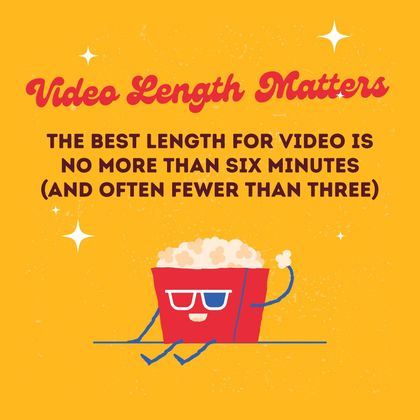How to Make Corporate Training Videos for Employees: 10 Tips
Tyler Campbell
🍿 5 min. read
Corporate training videos have become an increasingly popular tool for organizations to educate and train their workforce. These videos provide a convenient, engaging, and cost-effective way to deliver critical information and skills to employees.
Adding corporate training videos to your company’s training toolbox just makes good sense. To celebrate the launch of our YouTube Channel, EdgePoint Learning has put together a guide to everything you need to know about building your own eLearning videos.
The major benefits of corporate training videos
When you add training videos for employees into your learning and development strategy, get ready to reap the following benefits.
1. Flexibility and accessibility
Training videos can be accessed on-demand and just-in-time, allowing employees to learn at their own pace and schedule. No more rounding up the entire staff or dropping all company functioning so the entire team can attend a training.
This flexibility also accommodates different learning styles and preferences, ensuring that employees can engage with the content when they are most focused and receptive.
Accessibility tools can be incorporated into video development to make them available to employees with disabilities. Please review Section508.gov's accessibility standards for video here.
👉Discover more: This guide covers how to build truly accessible eLearning for your employees.
2. Consistency and standardization
Companies with more than one location appreciate this: corporate training videos ensure that all employees no matter their location receive the same information, presented in a consistent manner. This standardization helps to eliminate misunderstandings or variations in training quality that may arise from live presentations or workshops.
Even better, if employees move from one office to another, there’s no need for separate training — everyone’s already on the same page.
3. Cost-effectiveness
Producing training videos for employees may be front-loaded with costs, but over time it’s more cost-effective than organizing in-person training sessions. This is especially true for organizations with a large or geographically dispersed workforce. Like other types of digital training, training videos can save on the costs associated with providing in-person training to a geographically dispersed workforce.
Once your videos are up and running, they can be used repeatedly without additional costs for facilitators or venues.
4. Increased retention and engagement
Well-produced training videos that incorporate multimedia elements, such as visuals, audio, and interactive components, can increase engagement and improve understanding. Utilizing videos with quizzes and assessments afterwards can also reinforce learning.
5. Global reach
Training videos standardized across the company can be translated and localized to cater to a global audience. This breaks down language barriers and promotes a consistent training experience for employees worldwide.
6. Monitoring and analytics
A key aspect of employee learning is monitoring and analyzing how your training program is working. Corporate training videos can be structured within a training program that tracks:
- Employee engagement
- Progress
- Performance
This data can be used to identify areas for improvement, measure the effectiveness of your training initiatives, and inform future training strategies.
How to create engaging corporate training videos
Knowing how to make training videos for employees goes beyond pointing a shaky iPhone at a reluctant employee. Creating engaging corporate training videos is essential for maximizing knowledge retention, promoting employee participation, and ensuring a positive learning experience.
Here are ten tips to help you develop effective and engaging training videos for your employees.
1. Define clear learning objectives and target audience
Begin by defining the goals and objectives of your training video. Identify the key takeaways, skills, or knowledge that your employees need to acquire.
Having a clear focus will help you design your video content effectively and keep your audience engaged. The following video describes what's included in a thorough training needs analysis to build your learning programs.
2. Optimize video length and structure for maximum engagement
Attention spans are limited, so aim to keep your videos short and to the point. Break down complex topics into smaller, digestible segments.
Video length matters, too. A large-scale study found the best length for video was no more than six minutes (and often fewer than three). This shorter approach will make it easier for employees to absorb and retain the information.

3. Use scriptwriting and storytelling techniques
Incorporate storytelling techniques to make your content more relatable and memorable. Whether using a speaker or text on screen, share real-life examples, case studies, or anecdotes to illustrate key concepts and demonstrate their practical application.
4. Trust the experts
Feature subject matter experts or experienced professionals in your videos to lend credibility to your content and provide valuable insights. These experts can share their knowledge, tips, and best practices with your employees.
5. Add high-quality audio and voiceover narration
High-quality audio and professional narration helps deliver your message in a way that everyone can understand (and hear!). Keep audio clean and narration clear. Be sure to include closed captioning for learners who are hard-of-hearing or may not be fluent in English.
6. Incorporate branding elements and consistent visual identity
Bump up your brand by incorporating branding elements and consistent visuals throughout your entire corporate training videos catalog. This visual reminder helps reinforce your company’s messaging across all platforms.
7. Effectively use stock and custom artwork
Use high-quality visuals, such as stock or custom-shot video clips and photos, illustrations, and animations, to support your message and enhance understanding. Visuals can help to break up long stretches of text or speech to maintain audience interest.
8. Incorporate interactive elements for user participation
After the video, include interactive elements (i.e., quizzes, polls, or discussion prompts) to keep your audience engaged and facilitate active learning. These features can also help you assess employee comprehension and identify areas that may require additional support.
9. Make it mobile
Ensure that your training videos are optimized for viewing on mobile devices, as many employees will access the content on smartphones or tablets.
Consider using responsive design and mobile-friendly platforms to facilitate a seamless viewing experience.
10. Test and refine the videos based on feedback
As with every type of training, take the time to test, evaluate, and refine your corporate training videos based on employee feedback. You can also check with managers to see if they notice a change (positive or negative) in performance after employees finish a video or video series.
Get help creating your corporate training videos
Corporate training videos are an engaging, effective, and scalable option that deepens and adds flexibility to your current workforce development. At EdgePoint Learning, we understand that you might not be the next Scorsese, but we can help.
We know what it takes to make best-in-class corporate training videos. Our library of demos and our new YouTube Channel are prime examples of what we can do for you. When you’re ready to head straight to video, get in touch.

